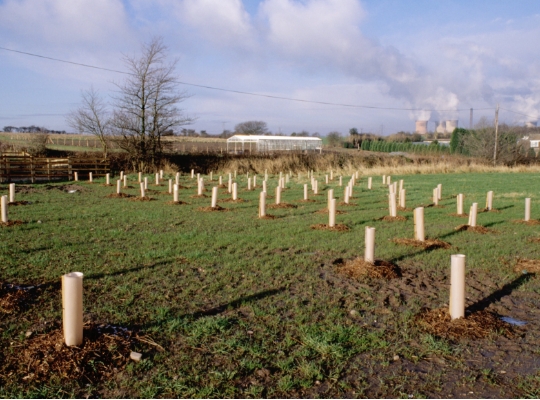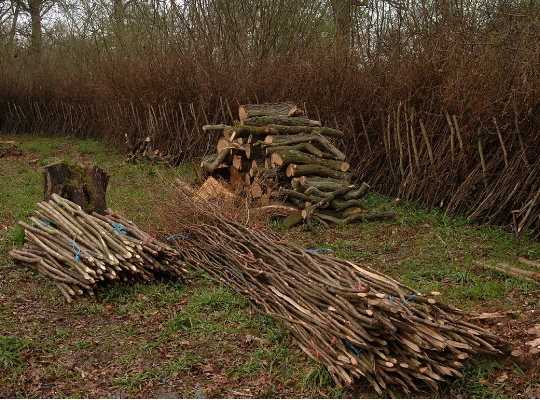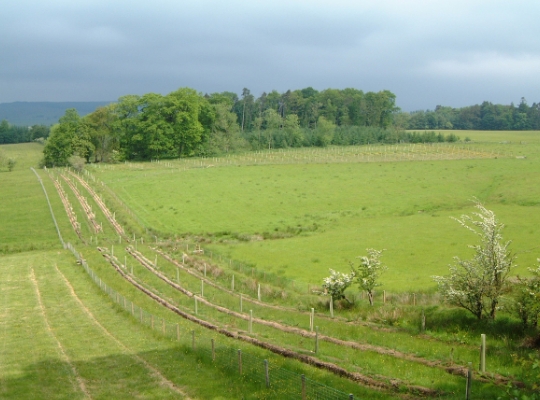The rapidly changing climate is being driven by the increase in greenhouse gas (GHG) concentrations in the atmosphere (chiefly carbon dioxide, CO₂, methane, CH₄ and nitrous oxide, N₂O).
These are being released by fossil fuel use and by deforestation and other land use changes. These changes in the land surface also affect the way the sun’s energy is dissipated through reflection, heating, or evaporation.
Climate change mitigation describes the measures which reduce GHG concentrations in the atmosphere, through decreasing or preventing their emissions, and removing greenhouse gases from the atmosphere.
The growth of trees and other woody plants results in CO₂ being taken out of the atmosphere to form woody tissues which are a major part of the ‘carbon stock’ of an area. Approximately 50% of the dry mass of woody material is carbon. A growing stand of trees therefore represents a net removal of CO₂ from the atmosphere. The carbon remains in the wood until released by decomposition (a slow process) or combustion (rapid).
During tree growth some of the organic carbon is also transferred to soils, through the roots, deadwood, and leaf litter. In many woodlands, the soil contains more carbon in litter layers, humus, and combined with soil minerals than held in the trees themselves. Cultivated soils often have much reduced carbon content, so tree planting and woodland creation in these soils usually results in an increase in soil carbon stocks, resulting in net removal of CO₂ from the atmosphere.


If trees are harvested and wood used in place of materials that are derived from fossil fuels, or that use more fossil fuel energy in their manufacture, then wood use can reduce fossil fuel use and the consequent greenhouse gas emissions. The net mitigation benefit will depend on the longevity of the wood product, and what it is replacing or ‘substituting’. Timber used in long-term construction to replace concrete, bricks or steel has a large benefit, while short-lived materials such as packaging and fencing will have less. While combustion of wood fuel will have the least benefit, it can still help to ‘keep fossil fuels in the ground’.
Increasing the domestic supply of timber from new or existing sustainably managed woodlands can reduce the demand for imported timber. This will reduce fuel use and emissions in transport as well as reducing the global demand that contributes to over-harvesting from natural forests and deforestation.
As well as mitigating the chief causes of climate change, trees and woodlands can also reduce the impacts of climate change to people, property, infrastructure and the wider environment. For example, woodlands can reduce surface run-off after high rainfall events, improve air quality, and provide shelter, shade and cooling for people in towns and cities, and for livestock and aquatic habitats in the countryside. These ecosystem services support the adaptation of other sectors to climate change, as long as the trees themselves are resilient.
In 2019, it was estimated that woodlands in the UK contribute about 19 million tonnes of carbon dioxide (CO₂ equivalent) of net carbon removal from the atmosphere, which is compensating for about 4% of the present UK’s in-territory emissions. As different sectors in society decarbonise, the importance of forestry’s contribution will increase. Creating new woodlands and managing existing woodlands better can increase that mitigation contribution, as well as contributing to many other benefits, including aiding the biodiversity crisis.
See our Funding & support page for details on official woodland creation schemes including grants.

However, as the climate continues to change, adaptation will be essential in order to ensure these mitigation benefits. If woodlands are not thriving, then their mitigation contribution is likely to be reduced. For example, species which are not suited to the future climate or are affected by new pests and diseases will no longer maintain the growth and productivity to ensure high rates of CO₂ uptake and/or timber production. Carbon stocks that have been accumulated as woodlands grow can also be lost through wildfire, windthrow, soil erosion, and die back or mortality from pests or diseases. The Climate Change Hub focuses primarily on climate change adaptation and further information on mitigation will be added in the future.
Trees and woodland play an important role in our national ‘Net Zero emissions’ targets, that is to reach zero net emissions by 2050. The devolved administrations have policies which outline these targets, and carbon budgets and plans outlining the pathways to meet them, details of which can be found on the official country guidance pages.
The UK Government’s Net Zero Strategy: Build Back Greener outlines the latest five-year carbon budget as required under The Climate Change Act 2008 (2050 Target Amendment) Order 2019, and longer-term vision for a decarbonized economy in 2050.
The Scottish Government’s plans to meet emissions reduction targets are presented in Securing a Green Recovery on a Path to Net Zero: Climate Change Plan 2018-2032 update which was updated in 2020 to meet the new and more ambitious targets in the amended Climate Change (Emissions Reduction Targets) (Scotland) Act 2019.
The Welsh Government approved a net zero target for 2050 in The Climate Change (Interim Emissions Targets) (Wales) (Amendment) Regulations 2021. The Welsh Government’s plans to meet the emissions reduction targets are outlined in five-yearly budgets, currently the Net Zero Wales Carbon Budget 2 (2021 to 2025).